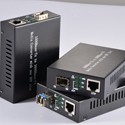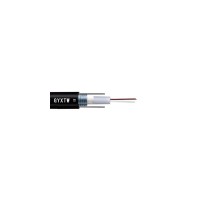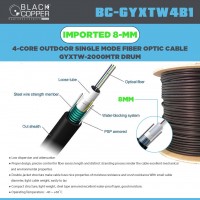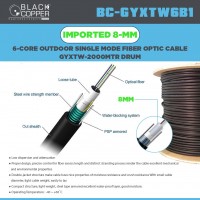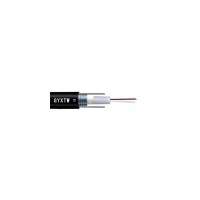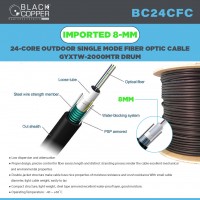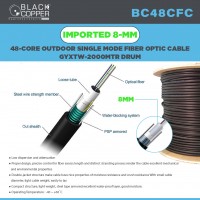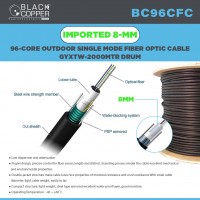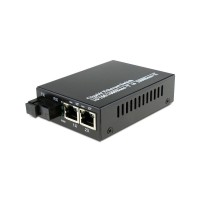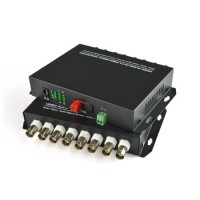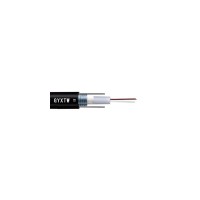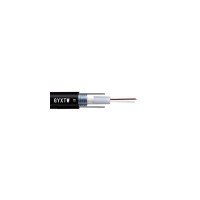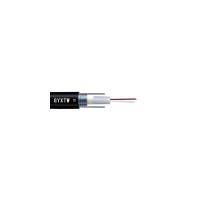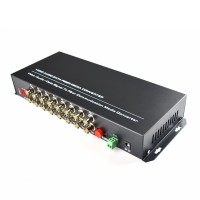No products
Fiber Optics
New products
-

BlackCopper BC-EGP-10G015-Z
Transform Your Business with BlackCopper BC-EGP-10G015-Z Dual Screen POS...
Rs 0
Catalog
The Power of Fiber Optics: Revolutionizing Communications
Fiber optics has emerged as a transformative technology, revolutionizing the way we communicate and access information. This revolutionary technology utilizes thin strands of glass or plastic, known as optical fibers, to transmit data as light pulses. With its exceptional speed, capacity...
The Power of Fiber Optics: Revolutionizing Communications
Fiber optics has emerged as a transformative technology, revolutionizing the way we communicate and access information. This revolutionary technology utilizes thin strands of glass or plastic, known as optical fibers, to transmit data as light pulses. With its exceptional speed, capacity, and reliability, fiber optics has become the backbone of modern communication networks, empowering businesses and individuals alike.
Unparalleled Speed and Bandwidth
Fiber optics offers unparalleled speed and bandwidth compared to traditional copper cables. Light travels significantly faster than electricity, enabling data transmission at lightning speeds. The vast bandwidth capacity of fiber optic cables allows for the simultaneous transmission of multiple data streams, supporting high-definition video streaming, online gaming, and other demanding applications without lag or interruptions.
Exceptional Reliability and Durability
Fiber optic cables are incredibly durable and resistant to electromagnetic interference (EMI). Unlike copper cables, which can be susceptible to signal degradation and data loss due to environmental factors, fiber optics transmits data as light pulses, making it immune to external interference. This inherent reliability ensures consistent and uninterrupted data flow, crucial for mission-critical applications.
Enhanced Security and Privacy
Fiber optics offers superior security and privacy compared to traditional communication methods. The light signals transmitted through fiber optic cables are not easily intercepted or tampered with. This makes fiber optics an ideal choice for sensitive data transmissions, such as financial transactions, healthcare records, and government communications.
Broad Applications Across Industries
Fiber optics has found wide-ranging applications across various industries. From telecommunications and broadcasting to healthcare and finance, fiber optics is revolutionizing data transmission and communication processes. In telecommunications, fiber optic cables are used to build high-speed internet networks, enabling seamless connectivity and faster download speeds. In healthcare, fiber optics plays a crucial role in medical imaging, remote surgery, and telemedicine, connecting patients with healthcare professionals across vast distances.
The Future of Communications
As technology continues to evolve, fiber optics will play an increasingly vital role in shaping the future of communication. With the rise of 5G networks, cloud computing, and the Internet of Things (IoT), the demand for high-bandwidth and reliable connectivity will only increase. Fiber optics is well-positioned to meet these challenges, providing the foundation for a connected and empowered society.
MB Communication: Pioneering Fiber Optic Solutions
MB Communication is a leading provider of fiber optic solutions, dedicated to delivering cutting-edge technology and exceptional customer service. We understand the transformative power of fiber optics and strive to empower businesses and individuals with reliable, high-performance connectivity solutions. Our team of experts is committed to providing tailored solutions to meet the unique needs of our clients, driving innovation and enhancing communications across industries.
Fiber Optics There are 13 products.
Subcategories
-
Media Converter
BlackCopper Media Converters: Your Gateway to Seamless Network Connectivity
In today's interconnected world, seamless data transmission is essential for businesses and individuals alike. Media converters play a crucial role in bridging the gap between different network technologies, enabling you to connect devices with diverse cabling systems. BlackCopper, a leading provider of network solutions, offers a wide range of media converters designed to meet your specific requirements.
Understanding Media Converters
Media converters act as a bridge between different types of network media, such as copper and fiber optic cables. They convert electrical signals from copper cables into optical signals for fiber optic cables and vice versa. This conversion allows you to extend your network over longer distances, improve signal quality, and enhance network performance.
BlackCopper Media Converter Advantages
BlackCopper media converters offer numerous advantages that make them an ideal choice for your network infrastructure:
- Wide Compatibility: BlackCopper converters support a wide range of network standards, including Ethernet, Fast Ethernet, Gigabit Ethernet, and 10 Gigabit Ethernet.
- Reliable Performance: BlackCopper converters are built with high-quality components and undergo rigorous testing to ensure reliable and consistent operation.
- Versatile Applications: BlackCopper media converters are suitable for a variety of applications, including network extensions, fiber-to-copper conversions, and fiber-to-fiber conversions.
- Cost-Effectiveness: BlackCopper offers a cost-effective solution for upgrading your network without significant infrastructure changes.
- Easy Installation: BlackCopper converters are designed for easy installation and configuration, minimizing downtime and disruption to your network operations.
Types of BlackCopper Media Converters
BlackCopper offers a comprehensive range of media converters to meet diverse needs. Some common types include:
- Copper to Fiber Media Converters: These converters convert electrical signals from copper cables to optical signals for fiber optic cables, allowing you to extend your network over longer distances.
- Fiber to Copper Media Converters: These converters convert optical signals from fiber optic cables to electrical signals for copper cables, enabling you to connect fiber optic networks to copper-based devices.
- Fiber to Fiber Media Converters: These converters convert optical signals from one type of fiber optic cable to another, providing flexibility in network design.
Applications of BlackCopper Media Converters
BlackCopper media converters find applications in various sectors, including:
- Data Centers: Media converters facilitate high-speed data transmission and network extensions within data centers.
- Enterprise Networks: Media converters enable seamless integration of fiber optic and copper-based networks within businesses.
- Industrial Automation: Media converters support reliable data communication in demanding industrial environments.
- Security and Surveillance: Media converters extend video surveillance systems over fiber optic cables, enhancing signal quality and security.
- Telecommunications: Media converters are used in telecommunication networks to connect different network segments.
Choosing the Right BlackCopper Media Converter
Selecting the appropriate media converter for your needs depends on various factors, such as:
- Network Speed: Consider the required data transmission speed for your network.
- Cable Type: Choose a converter compatible with your existing cabling infrastructure.
- Distance: Select a converter that can support the required cable distance.
- Application: Consider the specific application for which the converter will be used.
MB Communication - Your Trusted Network Partner
MB Communication, a leading provider of communication solutions, offers a wide range of BlackCopper media converters to meet your specific requirements. Our team of experts can assist you in choosing the right converters and provide technical support to ensure seamless network integration.
Contact us today to learn more about BlackCopper media converters and how they can enhance your network connectivity. Let MB Communication be your trusted partner in building a robust and reliable network infrastructure.
-
Fiber Optic Cables
BlackCopper Fiber Optic Cables: The Future of Connectivity
BlackCopper Fiber Optic Cables are at the forefront of connectivity technology, offering unparalleled speed, reliability, and performance. These cables are designed to meet the demands of today's high-bandwidth applications, ensuring seamless data transmission for businesses and individuals alike.
The Advantages of BlackCopper Fiber Optic Cables
- Unmatched Speed: BlackCopper Fiber Optic Cables transmit data at the speed of light, allowing for lightning-fast downloads, uploads, and streaming.
- Superior Reliability: Unlike traditional copper cables, fiber optic cables are immune to electromagnetic interference (EMI) and radio frequency interference (RFI), ensuring consistent and reliable data transmission even in challenging environments.
- Exceptional Bandwidth: BlackCopper Fiber Optic Cables offer incredible bandwidth capacity, capable of handling vast amounts of data with ease.
- Long-Distance Transmission: Fiber optic cables can transmit data over long distances without signal degradation, making them ideal for large networks and infrastructure projects.
- Enhanced Security: Fiber optic cables are highly secure, making them an ideal choice for sensitive data transmission.
- Future-Proof Technology: As technology continues to advance, fiber optic cables will remain a reliable and scalable solution for future connectivity needs.
BlackCopper Fiber Optic Cables: Applications and Industries
BlackCopper Fiber Optic Cables are used in a wide range of applications and industries, including:
- Telecommunications: Fiber optic cables are the backbone of modern telecommunications networks, providing high-speed internet, phone lines, and cable television services.
- Data Centers: Data centers rely on fiber optic cables to connect servers, storage devices, and other critical infrastructure, ensuring high-performance and reliable data storage and processing.
- Healthcare: Fiber optic cables are used in medical imaging equipment, telemedicine, and other critical healthcare applications, ensuring accurate and reliable data transmission.
- Manufacturing: Fiber optic cables are employed in industrial automation, robotics, and other manufacturing processes, enabling high-speed data transmission and control.
- Government: Government agencies utilize fiber optic cables for secure communications, data storage, and critical infrastructure operations.
- Education: Fiber optic cables play a vital role in modern education systems, providing high-speed internet access, online learning platforms, and interactive learning experiences.
Why Choose BlackCopper Fiber Optic Cables?
BlackCopper Fiber Optic Cables are the superior choice for connectivity, offering unparalleled performance, reliability, and future-proof technology. MB Communication, a trusted provider of communication solutions, offers a wide range of BlackCopper Fiber Optic Cables to meet your specific needs.
Contact us today to learn more about BlackCopper Fiber Optic Cables and how they can enhance your connectivity experience.
-
Fusion Splicer
Fusion Splicers: A Comprehensive Guide
Fusion splicing is a critical technique in fiber optic communication, offering a reliable and permanent connection for high-performance networks. Fusion splicers play a pivotal role in this process, enabling precision alignment and fusion of fiber optic cables. This comprehensive guide delves into the intricacies of fusion splicers, providing valuable insights for anyone involved in fiber optic installation or maintenance.
Understanding Fusion Splicers
A fusion splicer is an advanced tool that utilizes an electric arc to melt and fuse the ends of two fiber optic cables. This process results in a strong and durable connection, minimizing signal loss and ensuring optimal data transmission.
Types of Fusion Splicers
Fusion splicers come in various types, each designed for specific applications and requirements. Some common types include:
- Handheld Fusion Splicers: Compact and portable, ideal for field installations and on-site repairs.
- Benchtop Fusion Splicers: Larger and more robust, suitable for high-volume splicing operations in controlled environments.
- Automated Fusion Splicers: Offer increased speed and precision, often used in manufacturing and production lines.
Key Features and Components
Fusion splicers typically consist of these essential components:
- Fiber Cleaver: Precisely cleaves the ends of fiber optic cables to ensure a clean and smooth surface for fusion.
- Fiber Alignment System: Accurately aligns the cleaved fiber ends for optimal fusion.
- Fusion Arc Generator: Generates a controlled electric arc to melt and fuse the fibers.
- Microscope: Allows visual inspection of the fusion process and quality control.
- Control Panel: Facilitates operation and adjustment of splicing parameters.
Fusion Splicing Process
The fusion splicing process involves several steps to ensure a successful and reliable connection:
- Fiber Preparation: Clean and prepare the fiber ends using a fiber cleaver to achieve a precise and clean surface.
- Fiber Alignment: Utilize the alignment system to accurately position the cleaved fiber ends for proper fusion.
- Arc Discharge: Initiate the electric arc to melt and fuse the fiber ends together, creating a strong bond.
- Visual Inspection: Inspect the fusion joint using a microscope to ensure its quality and integrity.
- Testing: Conduct optical power measurements and other tests to confirm the quality of the connection.
Benefits of Fusion Splicing
Fusion splicing offers numerous advantages over other fiber connection methods, making it the preferred choice in high-performance networks:
- Low Loss: Fusion splicing minimizes signal loss, ensuring high data transmission speeds.
- High Reliability: Provides a permanent and robust connection, reducing the risk of signal degradation or connection failures.
- Versatility: Applicable to various fiber types and sizes, including single-mode and multimode fibers.
- Durability: Fusion spliced connections can withstand extreme temperatures and environmental conditions.
- Long-Term Performance: Ensures long-term reliability and performance, minimizing the need for maintenance or replacements.
Fusion Splicers and MB Communication
MB Communication recognizes the crucial role of fusion splicing in ensuring high-quality fiber optic networks. We offer a wide range of fusion splicing solutions, catering to diverse needs and applications. Our expertise and commitment to customer satisfaction have made us a trusted partner in the fiber optic industry.
Conclusion
Fusion splicing is an indispensable technology for creating reliable and high-performance fiber optic networks. Fusion splicers play a critical role in this process, enabling precise alignment and fusion of fiber optic cables. Understanding the various types, features, and applications of fusion splicers is crucial for anyone involved in fiber optic installation or maintenance.
MB Communication remains committed to providing innovative and reliable fusion splicing solutions, empowering our customers to build robust and future-proof fiber optic networks.
-
Black Copper BC-GYXTW2B1
2-Core Outdoor Single Mode Fiber Optic CableGYXTW-2000mtr Drum
Rs 22In Stock -
Black Copper BC-GYXTW4B1
4-Core Outdoor Single Mode Fiber Optic CableGYXTW-2000mtr Drum
Rs 92In Stock -
Black Copper BC-GYXTW6B1
6-Core Outdoor Single Mode Fiber Optic CableGYXTW-2000mtr Drum
Rs 110In Stock -
Black Copper BC-GYXTW12B1
12-Core Outdoor Single Mode Fiber Optic CableGYXTW-2000mtr Drum
Rs 170In Stock -
Black Copper BC24CFC
BlackCopper 24-Core Fiber Optic Cable, top performance cable with good material quality (Imported Cable)
Rs 220In Stock -
Black Copper BC48CFC
BlackCopper 48-Core Fiber Optic Cable, top performance cable with good material quality (Imported Cable)
Rs 390In Stock -
Black Copper BC96CFC
BlackCopper 96-Core Fiber Optic Cable, top performance cable with good material quality (Imported Cable)
Rs 750In Stock -
Black Copper Single Fiber 1310/1550
Black Copper Single Fiber 1310/1550 AB Gigabit Ethernet Fiber Media Converter SINGLE FIBER 10/100/1000BASE-TX TO 1000BASE-EX GIGABIT ETHERNET STANDALONE FIBER MEDIA CONVERTER, 1-PORT FIBER & 1-PORT RJ45, 1310NM SINGLEMODE, 20KM
Rs 7,800In Stock -
Black Copper 8 Channel Fiber Optic Media...
8 Channel *1080P HD Video/Data/Audio Fiber Optic Media Converter
Rs 46,470In Stock -
Black Copper BC-24-Core-FiberCable
24-Core Fiber Cable Single Mode Imported CableBlack Copper 24-Core Fiber Optic Cable, top performance cable with good material quality (Imported Cable)
Rs 196Out of stock -
Black Copper BC-48-Core-FiberCable
48-Core Fiber Cable Single Mode Imported CableBlack Copper 48-Core Fiber Optic Cable, top performance cable with good material quality (Imported Cable)
Rs 330Out of stock -
Black Copper BC-96-Core-FiberCable
96-Core Fiber Cable Single Mode Imported CableBlack Copper 96-Core Fiber Optic Cable, top performance cable with good material quality (Imported Cable)
Rs 639Out of stock -
Black Copper 16 Channel Fiber Optic Media...
16 Channel *1080P HD Video Audio Data Fiber Optic Media Converter Transmitter & Receiver Single Mode Single Fiber FC 20km
Rs 85,000Out of stock





